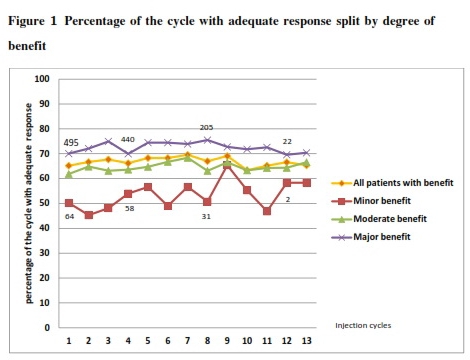Session Information
Date: Thursday, June 23, 2016
Session Title: Clinical trials and therapy in movement disorders
Session Time: 12:00pm-1:30pm
Location: Exhibit Hall located in Hall B, Level 2
Objective: To explore 1) relationship between peak benefit and Duration of Adequate Response (DAR) after BoNT, 2) frequency & causes of secondary Treatment Failure (TF), and effectiveness of TF management strategies.
Methods: Retrospective longitudinal study of routine service data in a BoNT clinic 1/4/12 to 31/3/15. On a standard diary (LIVECHART) for each cycle, patients reported: degree of benefit on a 7-point Likert scale (major deterioration-major benefit); DAR (weeks). Secondary TF cycles were analysed by case notes review for patients with at least 3 injection cycles, with a beneficial cycle followed by TF, and a subsequent further injection.
Results: There were 4845 cycles from 961 patients: 541 cervical dystonia, 57 blepharospasm, 118 other dystonia, 97 hemifacial spasm, 148 spasticity. Mean number of injection cycles/patient was 4.3+2.8(1-13). There were 3900(94%) cycles with “benefits”, and 258(6%) rated “no effect or worse”. Mean DAR(weeks+SD) was 12.7+5.5, 10.7+4.4 and 8.3+4.3 in cycles with major, moderate and minor benefits, respectively (p <0.001).
| Peak effect | Minor benefit | Moderate benefit | Major benefit | p value | ||
| Mean + SD, weeks (number) | ||||||
| Onset interval | 2.0 + 1.4 (365) | 1.7 + 1.1 (1259) | 1.4 + 0.9 (1577) | <0.001* | ||
| Duration of Adequate Response | 8.3 + 4.3 (339) | 10.7 + 4.4 (1218) | 12.7 + 5.5 (1494) | <0.001* | ||
| Duration of wearing off | 6.0 + 4.4 (365) | 4.2 + 3.5 (1299) | 3.8 + 3.7 (1644) | <0.001* | ||
| Interval between injection | 16.0 + 5.4 (423) | 16.5 + 6.0 (1380) | 17.6 + 6.6 (1769) | <0.001* | ||
 99 secondary TF cycles were analyzed. In 56/99(56.6%) there was no apparent cause. The next injection was successful after 38/56(68%) TF cycles, designated “Singular Unexplained Treatment Failures” (SUTF). Overall, SUTF occurred in 38/4845(0.91%) cycles. After a no-apparent-cause TF cycle, 26/56(46%) received repeat injection, with benefit in 18/26(69%). 30/56(54%) received changed injections, with benefit in 20/30(67%) (p = 0.83). Changing toxin brand was a potential cause of TF in 26/43(61%). 16/26(62%) reverted to the previous brand, 14/16(88%) successfully. 10/26(38%) continued the new brand, with benefit in the next cycle in 3/10, (p = 0.008).
99 secondary TF cycles were analyzed. In 56/99(56.6%) there was no apparent cause. The next injection was successful after 38/56(68%) TF cycles, designated “Singular Unexplained Treatment Failures” (SUTF). Overall, SUTF occurred in 38/4845(0.91%) cycles. After a no-apparent-cause TF cycle, 26/56(46%) received repeat injection, with benefit in 18/26(69%). 30/56(54%) received changed injections, with benefit in 20/30(67%) (p = 0.83). Changing toxin brand was a potential cause of TF in 26/43(61%). 16/26(62%) reverted to the previous brand, 14/16(88%) successfully. 10/26(38%) continued the new brand, with benefit in the next cycle in 3/10, (p = 0.008).
Conclusions: 1) In patients with higher peak benefit the Duration of Adequate Response was longer; 2) After Treatment Failure (TF), clinicians selected strategies that resulted in benefit for the majority; 3) TF on switching toxin brands (mostly for service rather than clinical reasons) responded more reliably to return to the previous brand than persisting with the new brand. We are investigating whether, why or how clinicians attempted to optimize the new brand; 4) Singular Unexplained TF was rare (0.91% cycles).
To cite this abstract in AMA style:
P. Tanvijit, A.P. Moore. Efficacy of 4845 botulinum toxin (BoNT) treatment cycles, and clinical strategies after a failed cycle [abstract]. Mov Disord. 2016; 31 (suppl 2). https://www.mdsabstracts.org/abstract/efficacy-of-4845-botulinum-toxin-bont-treatment-cycles-and-clinical-strategies-after-a-failed-cycle/. Accessed January 5, 2026.« Back to 2016 International Congress
MDS Abstracts - https://www.mdsabstracts.org/abstract/efficacy-of-4845-botulinum-toxin-bont-treatment-cycles-and-clinical-strategies-after-a-failed-cycle/
